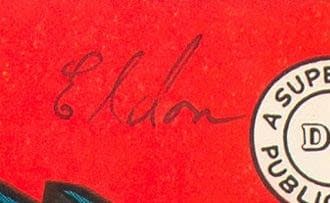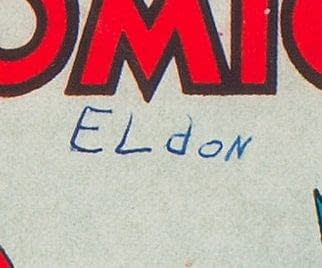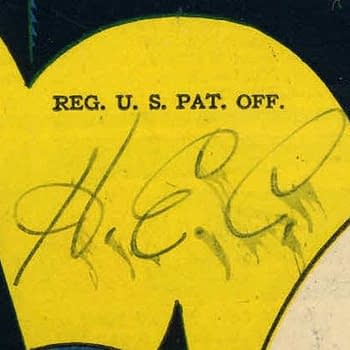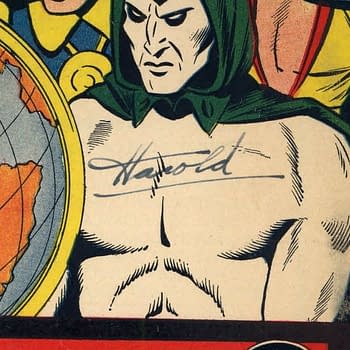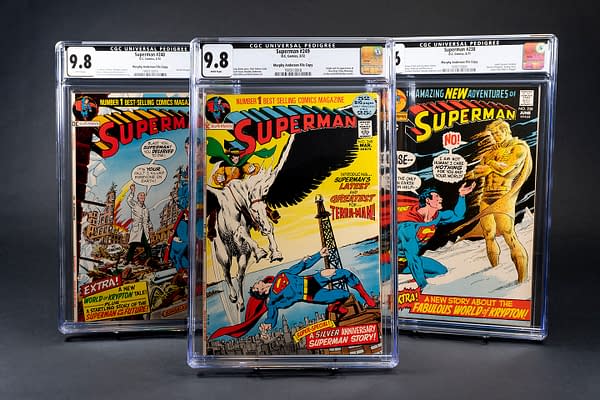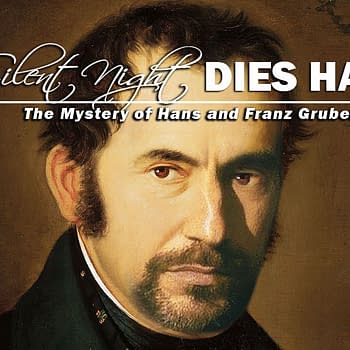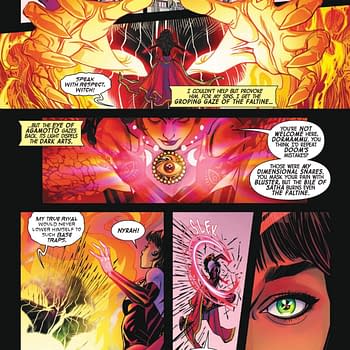Posted in: CGC Insider, Comics, Vintage Paper | Tagged: cgc
CGC Announces a New Pedigree Label and Newly Recognized Collections
Certified Guaranty Company® (CGC®) has released a new Pedigree Certification Label. This new black and white label is a way to differentiate exceptional comic book collections known as pedigrees, and will display "CGC Universal Pedigree" in place of "CGC Universal Grade". Only pedigrees that qualify for a Universal grade will receive the new label.
These new labels will be applied to books submitted as a CGC recognized pedigree through the online submission form starting on July 12th, and first available for show submissions at San Diego Comic Con on July 17th.
A new pedigree is considered when a collection of vintage books in high grade condition is introduced to the collectors market by the original owner. Many pedigree collections were recognized and accepted by the hobby before CGC came into existence.
CGC is also excited to add five new collections to the list of recognized pedigrees. This brings the total number to 59 pedigrees, all of which will be featured on the CGC pedigree site page next week.
Five New Pedigree Collections
NEW HAMPSHIRE
Assembled by a young man who was born around 1929, the New Hampshire pedigree contains approximately 1,400 books mainly representing the western genre of the late '40s and '50s. This collection contains more western comics than almost any other pedigreed collection. In 1989 the man sold his collection through an agent to Jim Payette, who in turn offered the books in his catalog. This was named the New Hampshire collection after the city in which the books surfaced. Many were subsequently purchased by Bob Overstreet. They are easily identified because of a distinct penciled date on each cover. Long considered a pedigree by collectors, CGC has finally recognized the collection's status.
COOKEVILLE
Named for its point of origin in Cookeville, Tennessee, the collection was assembled by Leroy Mackie and his brother, and later acquired by Steve Geppi in 1992. It contained nearly 5,000 superhero comics from the late '30s to the early '50s. In 2019 CGC officially recognized its pedigree status. Cookeville copies are easy to identify because of an "SN" mark written by Mackie's sisters who worked at the store from which he and his brother purchased comics. Occasionally the name "Leroy Mackie" was also written on the cover.
ELDON
Even though it appears the Eldon collection surfaced in the late '80s, CGC did not officially recognize it as a pedigree until now. The size of the collection is unknown, but many comics from the '40s have surfaced over the years with the name "Eldon" written on the cover in pen, either printed or in cursive. Subsequent research has revealed that his last name was Hamman, born in 1934 in Iowa, and he served in the Army during the Korean War. He passed away in 1987, likely leading to the sale of his collection. Many rare and key issues were present, including a Captain America Comics #1.
HAROLD CURTIS
One of the few collections to be almost completely CGC graded and sold at once, the Harold Curtis collection is exactly 519 books and spans over a decade, starting in 1940 and peaking during the years 1941-1946. The focus was predominantly DC superhero. Strangely enough, the collection is void of any titles beginning with the letters E through O, as well as any Superman issues. Over 65% of the collection exhibits identifying marks, usually Harold Curtis's name written on the front covers in pen. Other markings include arrival dates and distributor letters. The entire collection was auctioned through Heritage in 2006.
The Murphy Anderson File Copy collection is the newest pedigree recognized by CGC this year. Heritage's first offerings of the just-announced Murphy Anderson File Copy CGCpedigree will appear in their weekly auction dated July 28-August 4, along with some books from the Annie Gaines Collection.
Murphy Anderson File Copy Pedigree
In addition to the substantial Silver and Bronze age original art from the Murphy Anderson Collection, this new pedigree consists of the famed DC artist's file copies spanning the 1950s-1980s, including such classics as Showcase #4 and incredible white-page, high-grade Silver and Bronze keys. Impressive selections can be found in all of Heritage's weekly online Comic auctions following the initial offering.
Annie Gaines Ashton Pedigree
Featured in Heritage's special-format online monthly auction "The MAD Collection of Annie Gaines Ashton," the Annie Gaines Ashton Pedigree offerings include entire MAD and Panic runs of Gaines File copies. This new pedigree of high-grade examples comes from the collection of Bill Gaines' estate, the greatest provenance EC and MAD collectors could hope for! The devoted auction runs from September 12-October 17.
Complete List of Pedigrees Recognized by CGC
ALLENTOWN
Purchased by Jim Payette and Stephen Fishler in 1987, the Allentowns only numbered 135 comics, but contained some of the highest graded copies of several key issues such as Detective Comics #27, Marvel Comics #1, Captain America #1 and Batman #1. The original owner had discovered his mother had saved his small collection when he found them in her closet. His acquaintance, a local antique dealer contacted six comic book dealers to place bids, with Payette and Fishler bidding the highest. Even though the comics do not exhibit any distinctive markings, nearly every copy has retained its provenance.
AURORA
In the fall of 1996 in Aurora, Colorado, a young man carrying a bag of comic books walked into Castaway Comics, owned by Dennis Grimm. It was the first of several bags that eventually accumulated into a large collection of over 2,000 comics – now known as the Aurora Collection. The collection came from the man's grandfather and covered many genres from the late '40s to the early '50s, with horror, western, crime, good-girl and science fiction being the most prominent genres. Most copies exhibit a distributor code written in grease pencil on the front cover.
BETHLEHEM
This massive collection of 18,000 comic books was assembled by Stanley Pachon in Bethlehem, PA, and stretched from 1950 into the Silver Age. It contained many popular 50's runs and a score of Marvel and DC keys. After Pachon passed away, the collection was sold to Joe Rainone and Phil Weiss in 1990. The Bethlehems were one of the first pedigreed collections to contain Silver Age, and many are easily identifiable by a store stamp found on the back covers.
BIG APPLE
The Big Apple collection is unique in a few ways. It was assembled by a man named James Hilton and its span is huge, beginning in 1939 and continuing 30 years to the end of the Silver Age. Even though Hilton passed away in 1968, it wasn't until 1993 that his nephew Ron discovered the collection in the family home. A part of the collection was ultimately sold through Christie's Auction House between 1994 and 2000. The Golden Age portion of the collection has whiter paper, particularly from 1944, and they exhibit a distinctive pencil mark on the front covers.
BILLY WRIGHT
One of the most recent Golden Age pedigrees recognized by CGC, it covers the 1936-1941 period numbering approximately 340 comics that included 67 #1 issues, an Action Comics #1 among them. Wright was nine years old when he started to amass his collection, passing away in 1994. His books were discovered in the basement after his wife also passed in 2011. Heritage auctioned the collection that same year, which sold for $3.4 million. Even though his name is written on a few covers, the collection does not have any distinctive markings.
BOSTON
Named for the city from which Bechara Maalouf hails, he unveiled a box of very high grade Silver Age books at a New York show in the '90s. An older couple began coming to the same show with similar boxes, who dealers realized was the source of Bechara's find. Mainly consisting of comics from 1964 to 1975, the Boston collection contained many duplicates, but did not exhibit any identifiable markings on the covers. Of note, the Fantastic Four #55 graded CGC 9.9, one of the few 9.9 grades assigned to a Silver Age comic book.
BOWLING GREEN
This collection originated from Bowling Green, Kentucky, and first surfaced for sale in the 1999 Sotheby's comic auction. It consisted of Marvel and DC issues spanning 1960-1980. Although some of the earlier issues were lower in grade, the condition improved considerably after 1964. Most copies exhibit a date stamp on the front cover.
CARSON CITY
One of four Golden Age pedigrees to contain all #1 issues, the Carson City collection was amassed by a man who hoarded periodicals from his tobacco and candy store during the '40s and '50s, storing them between newspapers inside two storage sheds. After his passing, his wife sold the contents of the sheds to Mark Wilson and Ernie Gerber in the early '90s. The collection yielded impressive key issues such as Marvel Comics #1, All Select #1, Mystery Men #1, and 1939 New York World's Fair. Some copies exhibit a "#1" written on the front cover in pencil.
CENTRAL VALLEY
The origin of the Central Valley collection is unknown. A trucker bought the books in an estate sale in Northern California and flipped them to Brian Peets in 1993, who decided to keep the collection intact for 13 years. Containing nearly 400 comic books, the Central Valley collection exhibits fresh, white copies from the late '30s to the early '50s, including many high grade Superman and Batman titles. Once Peets decided to sell the collection, he had most of them CGC graded. Although some copies exhibit a date stamp, a store stamp or a penciled letter on the cover, the markings are not consistent.
CHICAGO
One of the oldest recognized pedigrees, the Chicago collection was purchased by Joe Sarno from the original owner in 1974. The most famous part of the collection includes near full runs of early Timely issues in high grade, which ultimately ended up in the hands of George Olshevsky, a well-known Timely historian. Olshevsy eventually sold his collection in 1988; prior to that he had meticulously penned a code number, date, and the condition of the book in the margin of an interior page of every issue, one way to identify a Timely Chicago copy. Many of these copies also have his initials penned on the last page.
CIRCLE 8
In 1992 this massive collection of 100,000 comics was discovered in a barn in Tuscon, Arizona by Greg Buls and Howard Harris. It was assembled through a used bookstore between 1955 and 1972 who discounted unsold comic books by writing a grease pencil "8" inside a circle, indicating a discount of 2 cents off the original 10 cent cover price. This practice continued as cover prices increased to 12 cents (with a grease pencil "10" written as the discount), 15 cents, and 20 cents, with an estimated 50% of the collection exhibiting the written discount. Of note, many of the highest graded horror and science fiction Atlas comics from the '50s hail from this pedigree.
COOKEVILLE
Named for its point of origin (Cookeville, Tennessee), the collection was assembled by Leroy Mackie and his brother, and acquired in 1992 by Steve Geppi after his passing. It contained many superhero titles, totaling nearly 5,000 comics from the late '30s to the early '50s. In 2019 CGC officially recognized its pedigree status. Cookeville copies are easy to identify because of an "SN" mark written by Mackie's sisters who worked at the store from which he and his brother purchased comics. Occasionally the name "Leroy Mackie" was also written on the cover.
COSMIC AEROPLANE
The second earliest recognized pedigree, this collection is famous for its distinct markings on interior pages. The collection was amassed by an art teacher during the '40s and '50s who used them for demonstrative purposes for students, applying numerous checkmarks and notations in pencil to the margins of interior pages. It was sold to David Faggiola, owner of the Cosmic Aeroplane Bookstore in Salt Lake City, Utah in 1972, and possibly numbered between 2,000 and 3,000 issues, containing many keys such as Adventure #40, Flash #1 and Showcase #4.
CROWLEY
Publisher William Crowley saved two copies of nearly every Fawcett comic book he produced during his tenure as editor throughout the '40s. In addition to runs of Captain Marvel, Whiz, Master and Wow, the collection also contained several western and romance titles, as well as comics from other publishers. Purchased and sold by Bechara Maalouf in the early 2000s, many Crowleys were CGC graded, and several can also be identified by a publisher stamp on the front cover.
CURATOR
Considered one of the best Silver Age collections ever discovered, the Curator boasts an Avengers #1 in 9.4, an Amazing Spider-Man #1 in 9.6, an X-men #1 in 9.8 and a Tales of Suspense #47 in 9.9, among many others. The collection began in the late '50s and continued into the '80s, its condition peaking in 1962. They were amassed by an employee of a museum (hence the name), who stored the comics in tight packs on the museum's premises. John Hauser acquired most of them in the '90s but sold many without a pedigree identification. As a result some copies have lost their pedigree as the books do not have any distinctive markings.
DAVIS CRIPPEN "D"
This Golden Age collection was second in size only to the extraordinary Edgar Church/Mile High accumulation, numbering roughly 13,000 issues and containing near complete titles from every company and genre between 1940 and 1955. It also has a distinctive history of discovery. About 2000 books were initially stolen from the Crippen house in 1991 and assimilated into the market as the "D" copies, named for the distinctive penciled code written at the top of the first page of each comic. Once Crippen passed away and the remainder of the collection was sold in 2006, the theft came to light and the origin of the pedigree was revealed.
DENVER
The Denver collection was assembled by a woman who ran a newsstand and carefully stored away 153 issues between 1938 and 1944. Even though it is one of the smallest pedigreed collections, every copy was a #1 issue, and included valuable keys like Batman #1, Captain America #1, Flash Comics #1, Green Lantern #1, Marvel Comics #1 and Sensation #1. The collection was purchased at an estate sale by local antique dealers, who in turn sold it to Joe Verenault. Many of the Denver copies are the highest graded on CGC's census. They do not exhibit any distinctive markings.
DON ROSA
A writer and illustrator for Disney that carried on the tradition of Carl Barks' famous works on Donald Duck, Rosa also assembled complete runs of every comic book published between 1966 and the late '80s, purchasing his books from local newsstands in Louisville, Kentucky. He decided to part with the 1970-present portion of his collection in 1995, sold through Steve Wyatt at San Diego Comic-Con that year. Rosa's remaining collection also contains a large, high grade accumulation of comics from the '50s, purchased complete by Rosa, which possibly represents a "pedigree within a pedigree." His collection has no identifying markings.
DON/MAGGIE THOMPSON
The Thompsons were responsible for several publications and writings during the '60s that helped bring together comic book fandom as we know it today. Already adults when Fantastic Four #1 was released in 1961, the Thompsons carefully stored away copies of most Marvel and DC comics throughout the '60s and '70s. Don passed away in 1994, and in 2013 Maggie decided to sell the collection through Heritage, resulting in nearly $1 million in sales, thanks to the pristine condition of their comics, which included an Avengers #1 and Tales of Suspense #39 in 9.4, a Journey into Mystery #83 in 9.2 and a Hulk #1 in 8.5.
EDGAR CHURCH/MILE HIGH
The most remarkable collection of vintage comic books ever discovered. The Mile High's immense size and extraordinary condition caused a major shift in both price structures and grading standards, and was the genesis of the pedigree concept in the comic book industry. It is the benchmark against which all other collections are compared.
Edgar Church, a commercial illustrator by trade, assembled the collection in his basement in Denver, Colorado between 1937 and 1957. He ultimately amassed nearly 15,000 comic books that included virtually every key issue from the Golden Age, and near complete runs of every title. After his passing in 1977 the family sold the contents to Chuck Rozanski, owner of Mile High Comics. Chuck slowly sold the books over the next several years, much of it to only a handful of people; most of the Mile Highs remained in private collections until the 2000s. There are several different styles of penciled arrival dates on the front covers that are used to identify Mile High copies, but the most consistent and recognizable are present on the issues between 1938 and 1945.
ELDON
Even though it appears the Eldon collection surfaced in the late '80s, CGC did not officially recognize it as a pedigree until recently. The size of the collection is unknown, but many comics from the '40s have surfaced over the years with the name "Eldon" written on the cover in pen, either printed or in cursive. Subsequent research has revealed that his last name was Hamman, born in 1934 in Iowa, and he served in the Army during the Korean War. He passed away in 1987, likely leading to the sale of his collection. Many rare and key issues were present, including a Captain America Comics #1.
GAINES
This pedigree is quite unique because it was amassed by Bill Gaines, the actual creator of the comics themselves. Gaines was the son of Max Gaines, a pioneer of the modern comic book, and rebranded his father's line of EC comics in the '50s, which reached a zenith in comic book art and storytelling that helped establish the collecting community in the '60s. He stored away 12 copies of every EC comic book he published between 1950 and 1955, placing them in brown paper wrappers. The collection was ceremoniously brought to market in 1992, only one year before his death. The comics have no distinctive markings, but each was sold with a certificate and they are easily identifiable by their pristine condition.
GREEN RIVER
Assembled by the most notorious collector of all the pedigrees, William J. Stevens II, who at one time was considered the prime suspect in the Green River serial killings. His father ran a drugstore in Spokane, Washington, from where Stevens and his brother took home comic books. Even though the actual serial killer was identified in 2001 using DNA tests, Stevens was a professional con man nonetheless, and after his death in 1991, his comic collection was sold to John Hauser to pay for legal fees. The collection consisted of nearly 1,700 Silver Age Marvel and DC, beginning around 1962, with most featuring a red date stamp on the front cover.
HAIGHT-ASHBURY
The only underground comic book pedigree, this collection totals about 500 issues between 1967 and 1982, stored away by an individual in San Francisco as the comics were published. In 2012, the owner sold the entire collection to Howard Greber, who subsequently had the collection pedigreed by CGC. Greber ultimately sold the collection through Heritage in 2015. It features some of the highest graded copies from a notoriously scarce genre in comic book history.
HAROLD CURTIS
One of the few collections to be almost completely CGC graded and sold at once, the Harold Curtis collection numbered exactly 519 books and spanned over a decade, starting in 1940 and peaking during the years 1941-1946. The focus was predominantly DC superhero. Strangely enough, the collection is void of any titles beginning with the letters E through O, as well as any Superman issues. Over 65% of the collection exhibits identifying marks, usually Harold Curtis's name written on the front covers in pen. Other markings include arrival dates and distributor letters. The entire collection was auctioned through Heritage in 2006.
HAWKEYE
Lacking any identifying markings, the Hawkeyes are distinguished by their very high grades, white pages, freshness similar to Mile High copies, and a noticeable mothball smell. The collection was sold piecemeal to Leroy Harper in Mason City, Iowa starting in 1984, who in turn sold a significant portion to Joe Smejkal, a collector from Texas. Every Saturday for one year a new group was sold to Harper, eventually totaling around 1,500 comic books that contained key issues such as Superboy #1, All-Star #3, More Fun #101, and Captain Marvel Adventures #1.
JOHN G. FANTUCCHIO
Fantucchio was a well-known artist in '60s fandom, drawing covers for RBCC and the Comic Buyers Guide (including the #1 cover), and even worked as an illustrator for the CIA from 1963 to 1988. During this time he amassed full runs of Marvel, DC, Gold Key, Charlton, ACG and Dell, among others, keeping them locked away and untouched, which resulted in uniformly high grades and near perfect cover inks. After his passing in 2016, the family auctioned the collection through Comiclink. Even though the books have no distinctive markings, many were CGC graded.
KANSAS CITY
The earliest pedigreed collection ever found, it turned up in Kansas City in the late '60s and featured a large accumulation of nearly 250 high grade #1 issues that ran from 1937 through the '40s. The people who purchased it sold only a handful of issues each year, but because the accumulation was not considered a pedigree until the '80s, and because they have no distinct markings, many copies have anonymously vanished into collections. Besides copies of Batman #1, Flash #1, Green Lantern #1, Planet #1, Jumbo #1, and Superman #1, the collection also contained one of only four pedigreed copies of Action Comics #1. That copy, graded CGC 8.0, was the first comic book to sell for $1 million in 2011.
LARSON
One of the earliest and most famous pedigrees, the Larson collection represented the rarest era of the Golden Age, 1936 to 1940. What makes Larson copies so recognizable is the name written on the cover of most copies. For years collectors wondered who Lamont Larson was, until the mystery was solved in the late '90s when the man himself emerged to tell his story. Besides depth of rarity, the Larson collection also contained many of the most valuable key issues, such as Action Comics #1, Marvel Mystery #1, All-American Comics #16 and Superman #1. The collection stopped abruptly in November 1941, but still numbered over 1,000 copies.
LOST VALLEY
Amassed by a young man who was a cryptographer in the Army Air Corps during WW II, the Lost Valley collection is one of a very few pedigrees to contain a significant number of comics from the rare '30s period, including Detective #1-27, and many early issues of More Fun, Adventure, Famous Funnies and Funny Pages. After the man passed away, the family ultimately sold the collection to Al Stoltz and Jeff Weaver in 2003. It was one of the first pedigreed collections to surface after CGC opened, and many copies were subsequently CGC graded.
MASS COPY
Marnin Rosenberg discovered this collection after responding to an ad in the Comic Buyers Guide in 1993. It contained approximately 4,000 comic books from the '60s to the '80s, including near complete runs of Marvel, DC, Gold Key, Charlton and ACG titles. Because The owner had stored the books in neat one-foot high stacks, making the preservation exceptional. The books do not exhibit any consistent markings, and much of the collection was assimilated without certificates.
MOHAWK VALLEY
This collection primarily consisted of runs of DC from the 1950 through the '60s, and was first offered through Sotheby's in 1995. Even though the cover tanning and lower page quality was pointed out, structurally the books are among the highest graded from the scarce period of DC in the mid to late '50s. Originating from the Mohawk Valley area in New York, the collection contained nearly all of the key issues produced by DC during the Silver Age, including an 8.5 copy of Showcase #4. Each copy from the collection included a certificate issued from Sotheby's, although the books do not exhibit any distinctive marks.
MURPHY ANDERSON FILE COPY
The newest pedigree recognized by CGC in 2019, and amassed by industry giant Murphy Anderson, one of the pre-eminent artists and inkers of the Silver Age. In addition to a large collection of original art, Anderson saved copies of many of the DC comic books published during his tenure from the '50s through the '70s. After his passing in 2015 the entire collection was auctioned through Heritage in 2019, many CGC graded.
NEW HAMPSHIRE
Assembled by a young man who was born around 1929, The New Hampshire pedigree contained approximately 1,400 books mainly representing the western genre of the late '40s and '50s, more western comics than almost any other pedigreed collection. In 1989 the man sold his collection through an agent to Jim Payette, who in turn offered the books in his catalog, named the New Hampshire collection after the city in which they surfaced. Many were subsequently purchased by Bob Overstreet. They are easily identified because of a distinct penciled date on each cover. Long considered a pedigree by collectors, CGC finally recognized the collection's status in 2019.
NORTHFORD
Containing predominantly '50s horror comic books, this collection was found in a chest of drawers sold to an antique dealer after the collector passed away in the early '70s. The dealer kept them until 1999, when he sold them to Metropolis Comics. It contained the most complete run of pre-code horror comic books out of all the pedigreed collections, and the copies are easily identified by a small stamp of an "x" within a circle found on the back covers.
NORTHLAND
Considered one of the best Silver Age pedigree collections to ever surface, it included runs of primarily Marvel and DC, as well as Gold Key, Dell, ACG, and Charlton, among others. Michael Goldman purchased the collection in 1996, where it debuted for sale at the Chicago convention that same year. He continued to sell copies through his catalog over the next several years. The Northland collection is known for its exceptional paper quality and particularly high grades during the scarcer period of Marvel between 1961 and 1964. Although the books do not have any identifying marks, a certificate was included with each copy.
NOVA SCOTIA
Similar to the Big Apple pedigree, this collection consisted of two parts; a small run of Golden Age DC's from the late '30s to early '40s, and another group of nearly 2,000 comics from the early '50s to the late '60s. The collection was part of an estate sale in 1994 which ultimately went to Jim Payette, who paid $85,000 after engaging in a bidding war with a Canadian dealer from Brunswick. Even though the early Golden Age portion was small, it contained high grade copies of Batman #1, Detective #31, #33, #35 and #38, and Superman #1-#3. These copies exhibit a small "m" written on the front covers in pencil.
OAKLAND
The Oakland collection came to be in 1998 after the original owner brought samples to the Wondercon Convention and struck a deal with Vincent Zurzolo and Mike Carbonaro, who proceeded to drive the collection from California to New York. In it were over 4,000 comic books, primarily between the years of 1966 and 1974, accumulated as the owner was paid in comics by a liquor store in return for stacking shelves. He was very meticulous when handling his books, evident by the very high grades and page quality assigned to the collection over time. The books were sold as Oakland copies, although none of the copies have identifying marks on their covers.
OHIO
This large collection surfaced in Akron, Ohio and spanned a 30 year period, beginning in the early '40s with a wide variety of publishers and genres. In 1994 the original owner, who wanted to remain anonymous, began selling the collection piecemeal through an intermediary. Nelson Dodds bought most of it over the next 18 months, who sold them to other dealers at the same time to keep up cash flow. He did not market them as a pedigree because he did not realize the enormity of the collection until the end. Totaling nearly 6,000 books, the Ohios are known for their freshness and high page quality and are identifiable by penciled distributor codes written on the front covers.
OKAJIMA
Admired for its unique backstory, the Okajima collection was assembled by a young Japanese-American girl from California who was interned by the U.S. government during World War II. She managed to save her comic books through that period, and continued collecting until the mid'50s. The collection was ultimately sold in 1995, broken into three groups during an estate sale, but because of their unique markings on the front and back covers many copies have been identified since their initial disbursement. The collection is known for having very high page quality and containing a large number of jungle and good-girl comics.
PACIFIC COAST
Considered the greatest Silver Age collection to ever surface, the Pacific Coast collection was brought to market by Robert Roter after he discovered portions of it for sale on eBay in 1999. The books were marketed through PCE over the next several years and contained over 7,000 comics and magazines that included Marvel, DC, and Gold Key among others, covering a time span between 1961 and 1977. Many of the highest graded Marvel and DC issues from the early '60s hail from this collection with exceptional page quality. The books do not exhibit any distinguishing markings.
PALO ALTO
Assembled by a man in the military during the Korean War, the collection numbered around 450 books covering the period between 1950 and 1954. He stored his collection in an airtight footlocker during this time and held onto the books until the '70s. Financial issues caused him to sell the collection to a younger soldier he knew. The books were subsequently stored in bags and retained until 1998 when they were sold to Lee Hester in Palo Alto, California. Containing many rare issues from a diverse time period in comic books, it was the first newly pedigreed collection by CGC shortly after their debut in 2000. The books do not have any distinguishing markings.
PENNSYLVANIA
In 1981, Steve Geppi was told about a collection near Lancaster, Pennsylvania by a broker named Birney. Birney took him to an elderly woman's home where stacks of Golden Age comics were piled throughout a room. There were about 1,000 comics in the collection, primarily from the 1941-1944 period, and contained mostly superhero comics from numerous publishers. The bulk of the books resided in personal collections for over a decade before they began appearing on the market. Their grades are among the highest of the pedigree collections and the books are easily identifiable by a cursive "P" penciled on the front covers.
RECIL MACON
Similar to the Larson collection, these books have the name "Recil Macon" written on the covers (and sometimes interior pages) of each comic. Like the Crippen collection, a small portion of them were stolen from Macon's home around 1990. Macon himself sold the remainder of the collection through Darren Wilson in Abilene, Texas a while later, but it was Greg Buls who ultimately advertised the books as a pedigree. The collection was estimated to have contained less than 1,000 issues, including many Timely books. Many have yet to resurface in the market due to being sold in small batches.
RIVER CITY
A collection of primarily '50s comics that mainly represented the horror and sci-fi genres, it is rumored to have contained as many as 4,000 books. It' impossible to confirm the exact number because the collection was sold to many different people and were not initially identified as a pedigree. Brian Peets purchased a large portion and unveiled them at the 1998 Wondercon convention. Stored in a shed in California, most copies bear a grease pencil distributor mark on the cover, making it possible to locate orphaned River City issues in the marketplace.
ROCKFORD
One of the most significant Golden Age collections to surface during the '90's, the Rockford pedigree contained large superhero runs from the '40s and included many valuable key issues, some of which rival the Mile High copies in grade. The original owner offered the collection to several dealers, with Mark Wilson emerging as the highest bidder. Wilson subsequently sold or auctioned the collection through several of his catalogs. The collection's breadth and depth led to its quick acceptance as a pedigree, and most copies are easily identifiable, exhibiting a small letter stamp of "R" or "W" on the front covers.
ROCKY MOUNTAIN
This pedigree was assigned to a large Marvel and DC Silver Age collection originally auctioned by Comiclink in 2008. The Spider-Man, Fantastic Four and X-men runs were first auctioned without pedigree, but due to high collector interest the decision was made by CGC to classify the collection as a pedigree. Subsequently those three runs were retroactively given the Rocky Mountain notation. Hailing from Colorado, the collection numbered around 5,000 books, initially stored in a basement in similar conditions to the Mile High collection. None of the books exhibit identifying marks, but are easily traceable back to Comiclink.
SALIDA
Frank Blankis assembled this collection primarily between the mid '40s and mid '50s. He was unable to join the military during WW II due to a handicap but managed to hang onto his books over the ensuing decades, eventually selling them to Bruce Ellsworth in 1994. Hailing from the pedigree friendly climate of Salida, Colorado, the collection is mainly noted for its exceptionally white pages (nearly all CGC graded copies have been assigned this page quality designation) and focused on DC and Atlas war titles, as well as Disney comics. Most of the copies have stamps on the back or front cover that read "Fred's News Stand", "Nor-Colo.", or a Blankis subscription stamp.
SAN FRANCISCO/ TOM REILLY
One of the earliest pedigree to surface, one of the highest graded, and one of the most enigmatic backstories all make the San Francisco collection irresistible to collectors. It is rumored that Tom Reilly began collecting comic books in the late '30s, but after he was drafted into the military, he asked his parents to continue buying comic books for him while he was gone. He was reportedly killed in a kamikaze attack near the end of the war, at which point the collection stops.
The collection surfaced in Northern California in the early '70s and was broken up among several dealers with no original list made. Being scattered long before the concept of pedigrees took hold, these books are only known because of a distinct (and indecipherable) name stamp present on the back covers. It has proven impossible to tell how big the original collection was, but the quality is considered second only to the Mile High pedigree, exhibiting white pages and an unmatched structural superiority.
SAVANNAH
Numbering around 40,000 makes this one of the largest collections ever pedigreed. It was assembled by a man born around World War I who began setting aside comic books in the '50s. He eventually befriended a local distributor who supplied him with comics each week, which he carefully stacked on shelves and in bins. He continued buying until his death at 95 in 2010; Shelton Drum was contacted to sell the collection, which was ultimately auctioned through Heritage in 2011. While it contained comics from every company, the Savannahs are best known for their DC comics, particularly the more esoteric genres like war, romance and western, which are not usually present in pedigree collections. The books have no identifying marks.
SPOKANE
Among the pedigree collections containing '50s comics, the Spokane ranks at the top in terms of whiteness and grade. It numbered about 1,000 books and largely contained horror and science fiction titles, as well as a large run of Batman and World's Finest. It originated in Spokane, Washington, but first surfaced for sale in New Orleans, Louisiana in 1998. Mark Haspel initially purchased 20% of the collection, and the rest were bought by Stephen Fishler and Vincent Zurzolo, who promoted them through the Comic Buyers Guide and Comic Book Marketplace magazines. Because the collection was sold as a pedigree, and most copies exhibit a date stamp on their covers, nearly all of the Spokane issues have retained their identity.
SUSCHA NEWS
The Suscha News pedigree offers a detailed insight into the mind of a collector during the '60s and '70s, chronicled by the original owner himself when his collection was sold to Metropolis in 2010. Born in 1949, he grew up in Wisconsin with a casual interest in comics until a friend introduced him to superheroes in 1963. His meticulous nature ultimately led him to strike a deal with his local distributor in the early '70s, named Suscha News, who allowed him to cherry pick his comics at half price. The deal ended in 1976, and his collecting soon after. The collection's most famous attribute are multiple copies of late '60s and '70s issues in pristine condition; the books are void of any identifying marks.
TWILIGHT
One of only a handful of pedigrees named after the store that brought them to market, this collection turned up near Twilight Books and Emporium in Syracuse, NY in the summer of 1995. The owner Bob Gray appraised the childhood collection of a customer that consisted of 600 Golden Age comics, including near complete runs of Batman #1-#59, Detective #27-#161, World's Finest #1-#30, Marvel Comics #1, and a handful of other Timelys. Gray realized he could not afford such a collection, and contacted numerous dealers in the Overstreet Price Guide to place bids. Metropolis and Four Color Comics split the collection with a winning bid of $274,000 and marketed the books through their catalogs. There are no identifying marks, but a certificate of authenticity accompanied all books.
TWIN CITIES
Gary Dahlberg spent his life carefully buying, reading and storing comic books away throughout the '60s and '70s, with aspirations to become a cartoonist one day. Sadly, he died in a fire in 2010, but to the astonishment of his family his collection was appraised at more than $1 million by Heritage, who auctioned the books in 2011. Consisting of mainly Marvel and DC, this accumulation has no identifying marks but yielded some of the highest grades of the early Marvel period with considerably high page quality. The collection ultimately brought over $2.4 million at auction.
VANCOUVER
One of the highest graded among all pedigrees with the whitest page quality, the Vancouver collection ran the gamut of genres from the '40s and '50s, containing a large number of single issues from different titles. The entire collection surfaced on eBay in 2003, but failed to sell, only to be purchased afterwards as a whole by one individual. The collection was eventually broken up and sold piecemeal. Vancouver copies do not exhibit any distinctive markings, but the collection's relatively small size and later discovery has allowed most to retain their origin.
WESTERN PENN
Surfacing in the '90s, much of this collection's history is shrouded in mystery. We know that both a father and his son accumulated the collection from the '60s to '80s, and there was allegedly a cache of Golden Age comics as well that may have been sold earlier (to date only a handful of Tarzans prior to 1961 have been CGC graded). Stuart Friedlander brought the collection to market, and several Silver Age publishers were represented, although Marvel was the predominant company. Known for very high grades and exceptional page quality starting in 1961, the Western Penn copies have been well documented, but do not exhibit any identifying marks.
WHITE MOUNTAIN
This collection came to prominence in the early '90s when a large portion of them sold through the first Sotheby's comic book auctions in 1991 and 1992, although the original owner had been selling books from it as early as 1984. Known for their whiteness and freshness, the collection covered much of the '50s and '60s, particularly horror and science fiction, and contained full runs of early Silver Age titles. It was one of the first major pedigrees to represent the Silver Age, laying the foundation for other prominent Silver Age pedigrees such as Pacific Coast, Curator, Western Penn, Northford and Mohawk Valley. Copies from the '50s contain a date stamp on the first page, while later issues exhibit a small two-digit year penned on the front cover.
WINDY CITY
Of the four pedigrees containing all #1 issues, this collection is by far the largest, numbering over 2,000 comics. It also covers one of the largest spans of time, running from the '30s through the '60s. Many of the most valuable key issues were present, including Marvel Comics #1, Captain America #1, Batman #1, Flash #1, Captain Marvel #1, All-Winners #1, Daring Mystery #1 and Whiz #1. The original owner Andy Wallace, an introverted postal worker who lived with his sister, wrote his name on nearly ¼ of the comics. Gary Colabuono purchased the collection piecemeal over eight years, but initially sold them without a pedigree status, although he did make a detailed original list.
WINNIPEG
This collection of Silver Age comic books was assembled in Winnipeg, Canada by two friends, Joe Krolic and Dennis Kjolso from the early '60s well into the '90s. In 1997 the collection was sold to Dan Greenhalgh, who in turn marketed them through his catalog. Consisting of full runs of every major Marvel title, nearly all issues prior to 1966 exhibit Kjolso's name written in blue ballpoint pen at the top of each cover. Many of the later issues were CGC graded and sold by Doug Schmell after CGC's opening in 2000. The collection is known for its high page quality and exceptional grades, particularly after 1964.







